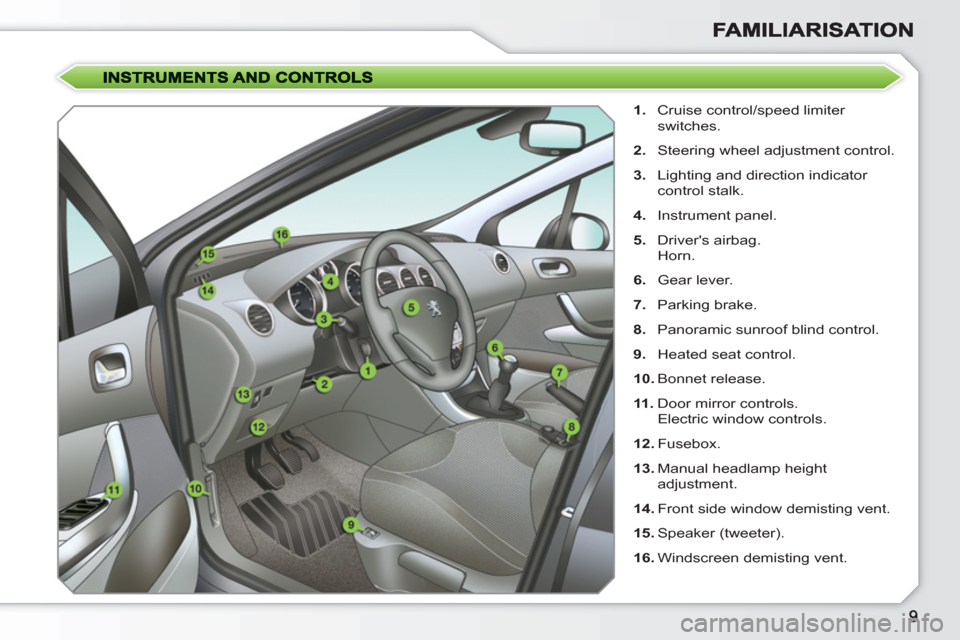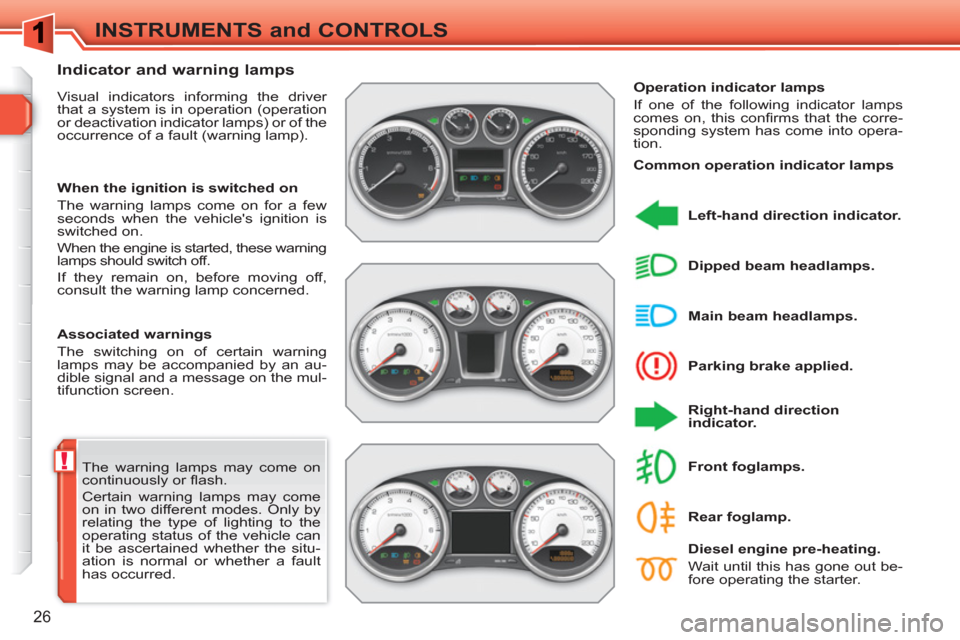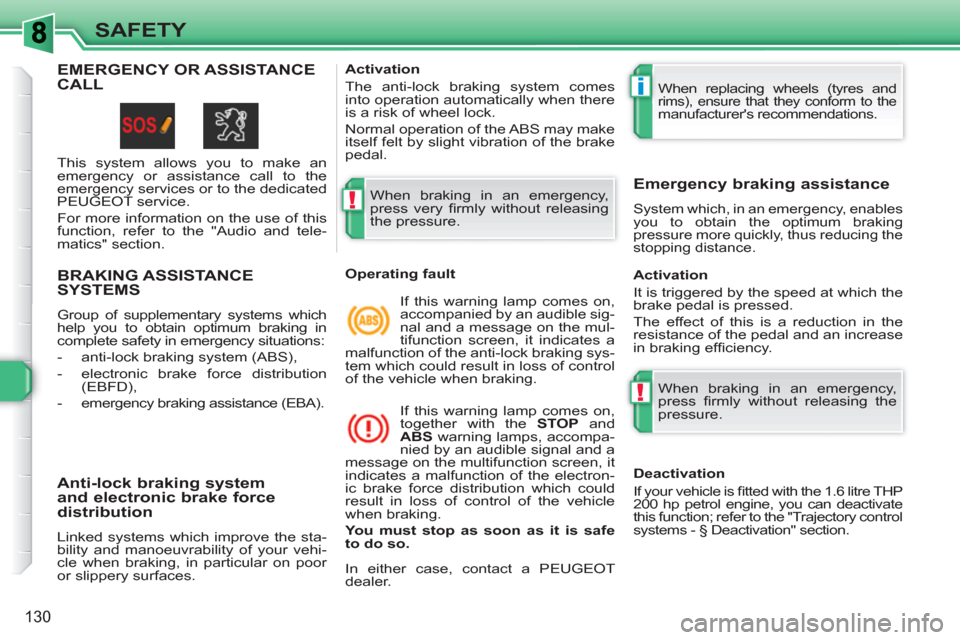2011 Peugeot 308 SW BL brake light
[x] Cancel search: brake lightPage 11 of 336

1.
Cruise control/speed limiter
switches.
2.
Steering wheel adjustment control.
3.
Lighting and direction indicator
control stalk.
4.
Instrument panel.
5.
Driver's airbag.
Horn.
6.
Gear lever.
7.
Parking brake.
8.
Panoramic sunroof blind control.
9.
Heated seat control.
10.
Bonnet release.
11 .
Door mirror controls.
Electric window controls.
12.
Fusebox.
13.
Manual headlamp height
adjustment.
14.
Front side window demisting vent.
15.
Speaker (tweeter).
16.
Windscreen demisting vent.
Page 28 of 336

!
26
INSTRUMENTS and CONTROLS
The warning lamps may come on
continuously or fl ash.
Certain warning lamps may come
on in two different modes. Only by
relating the type of lighting to the
operating status of the vehicle can
it be ascertained whether the situ-
ation is normal or whether a fault
has occurred.
Indicator and warning lamps
Visual indicators informing the driver
that a system is in operation (operation
or deactivation indicator lamps) or of the
occurrence of a fault (warning lamp).
Associated warnings
The switching on of certain warning
lamps may be accompanied by an au-
dible signal and a message on the mul-
tifunction screen.
Operation indicator lamps
If one of the following indicator lamps
comes on, this confi rms that the corre-
sponding system has come into opera-
tion.
Left-hand direction indicator.
Parking brake applied.
Right-hand direction
indicator.
Main beam headlamps.
Dipped beam headlamps.
Diesel engine pre-heating.
Wait until this has gone out be-
fore operating the starter.
Front foglamps.
When the ignition is switched on
The warning lamps come on for a few
seconds when the vehicle's ignition is
switched on.
When the engine is started, these warning
lamps should switch off.
If they remain on, before moving off,
consult the warning lamp concerned.
Common operation indicator lamps
Rear foglamp.
Page 31 of 336

!
29
INSTRUMENTS and CONTROLS
When the engine is running or the ve-
hicle is moving, the lighting of one of the
following warning lamps indicates the
occurrence of a fault requiring interven-
tion on the part of the driver.
Central alert.
Lighting is associated with
the displaying of another
warning lamp:
- punctured wheel,
- braking,
- power steering,
- engine oil pressure,
- coolant temperature,
stop the vehicle as soon as it is safe to
do so.
Service.
If this comes on, it indicates the
occurrence of a problem in one
of the systems which does not
have a specifi c warning lamp.
To identify the problem, consult the
message on the multifunction screen.
Braking.
If this comes on, it indicates the
occurrence of a fault in one of
the braking systems:
- signifi cant drop in the brake fl uid
level,
- electronic brake force distribution
(EBFD) faulty (simultaneous
lighting of the ABS warning lamp),
stop the vehicle as soon as it is safe to
do so.
When the vehicle is moving, check that
the parking brake is fully released. Any fault resulting in the displaying
of a warning lamp must be investi-
gated further by reading the associ-
ated message on the multifunction
screen.
In the event of diffi culty, do not
hesitate to contact a PEUGEOT
dealer.
Warning lamps
Common warning lamps After checking:
- that the doors, boot, the rear
screen and bonnet are closed,
- the engine oil level,
- the screenwash fl uid level,
- the remote control battery,
- the pressure of the tyres,
- the end of saturation of the particle
emission
fi lter (Diesel),
for any other situations, contact a
PEUGEOT dealer.
Anti-lock braking system
(ABS).
If this comes on, it indicates the
occurrence of a fault in the anti-
lock braking system.
However, this does not prevent op-
eration of the vehicle's servo-assisted
braking.
Page 34 of 336

!
32
INSTRUMENTS and CONTROLS
Airbags.
If this is displayed, it indicates
the occurrence of a fault in one
of the airbag or pretensioning
seat belt systems.
Braking.
If this is displayed, it indicates
the occurrence of a fault in one
of the braking systems:
- signifi cant drop in the brake fl uid
level,
- electronic brake force distribution
(EBFD) faulty (simultaneous
lighting of the ABS warning lamp).
Stop the vehicle as soon as it is safe to
do so.
If the vehicle is moving, check that the
parking brake is fully released.
Anti-lock braking system
(ABS).
If this is displayed, it indicates
the occurrence of a fault in the
anti-lock braking system.
However, this does not prevent op-
eration of the vehicle's servo-assisted
braking.
Door open.
A door, the boot or the rear
screen is open:
Parking brake.
If this is displayed, while the ve-
hicle is moving, it indicates that
the parking brake has not been
fully released.
Electronic immobiliser.
If this is displayed, it indicates
the occurrence of a fault in the
electronic engine immobiliser
system or that the remote control bat-
tery is fl at.
Fuel level.
When this fi rst comes on, you
have approximately 6 litres
of
fuel remaining in the tank
Refuel as soon as possible to avoid run-
ning out of fuel.
Until suffi cient fuel has been added,
this warning lamp comes on again each
time the ignition is switched on, along
with an audible signal and a message.
According to version, this audible signal
and this message are repeated, at in-
creasingly shorter intervals as the level
decreases towards "0"
.
Capacity of the tank: approximately
60 litres
.
Screenwash fl uid level.
If this is displayed, following an
action on the wiper stalk, it indi-
cates that the screenwash fl uid
level is low.
Fill the screenwash/headlamp wash fl uid
reservoir when you next stop.
-
if the speed is below 6 mph (10 km/h),
this warning lamp is displayed in orange,
- if the speed is higher than 6 mph (10 km/h),
this warning lamp is displayed in red.
Never continue to drive until you
run out of fuel, this could damage
the emissions control and injection
systems.
Engine oil pressure.
If this is displayed, it indicates
the occurrence of a fault in the
engine lubrication circuit. Stop
the vehicle as soon as it is safe
to do so.
Engine oil level.
If this is displayed, it indicates
that the engine oil level is too
low. Stop the vehicle as soon
as it is safe to do so.
Coolant temperature.
If this is displayed, it indicates
that the temperature in the cool-
ing system is too high. Stop the
vehicle as soon as it is safe to
do so.
Coolant level.
If this is displayed, it indicates
that the coolant level is too low.
Stop the vehicle as soon as it is
safe to do so.
Page 132 of 336

!
i
!
130
SAFETY
BRAKING ASSISTANCE SYSTEMS
Group of supplementary systems which
help you to obtain optimum braking in
complete safety in emergency situations:
- anti-lock braking system (ABS),
- electronic brake force distribution
(EBFD),
- emergency braking assistance (EBA).
Anti-lock braking system
and electronic brake force
distribution
Linked systems which improve the sta-
bility and manoeuvrability of your vehi-
cle when braking, in particular on poor
or slippery surfaces.
When braking in an emergency,
press very fi rmly without releasing
the pressure.
When replacing wheels (tyres and
rims), ensure that they conform to the manufacturer's recommendations.
Operating fault
If this warning lamp comes on,
accompanied by an audible sig-
nal and a message on the mul-
tifunction screen, it indicates a
malfunction of the anti-lock braking sys-
tem which could result in loss of control
of the vehicle when braking.
If this warning lamp comes on,
together with the STOP
and
ABS
warning lamps, accompa-
nied by an audible signal and a
message on the multifunction screen, it
indicates a malfunction of the electron-
ic brake force distribution which could
result in loss of control of the vehicle
when braking.
You must stop as soon as it is safe
to do so.
Emergency braking assistance
System which, in an emergency, enables
you to obtain the optimum braking
pressure more quickly, thus reducing the
stopping distance.
Activation
The anti-lock braking system comes
into operation automatically when there
is a risk of wheel lock.
Normal operation of the ABS may make
itself felt by slight vibration of the brake
pedal.
Activation
It is triggered by the speed at which the
brake pedal is pressed.
The effect of this is a reduction in the
resistance of the pedal and an increase
in braking effi ciency.
In either case, contact a PEUGEOT
dealer. When braking in an emergency,
press fi rmly without releasing the
pressure.
EMERGENCY OR ASSISTANCECALL
This system allows you to make an
emergency or assistance call to the
emergency services or to the dedicated
PEUGEOT service.
For more information on the use of this
function, refer to the "Audio and tele-
matics" section.
Deactivation
If your vehicle is fi tted with the 1.6 litre THP
200 hp petrol engine, you can deactivate
this function; refer to the "Trajectory control
systems - § Deactivation" section.
Page 151 of 336

!
i
149
DRIVING
Stopping the vehicle
Before switching off the engine, you
can engage position P
or N
to place the
gearbox in neutral.
In both cases, apply the parking brake
to immobilise the vehicle.
Operating fault
When the ignition is on, the
lighting of this warning lamp,
accompanied by an audible sig-
nal and a message on the mul-
tifunction screen, indicates a gearbox
malfunction.
In this case, the gearbox switches to
emergency mode and is locked in 3rd
gear. You may feel a substantial knock
when changing from P
to R
and from N
to R
. This will not cause any damage to
the gearbox.
Do not exceed a speed of 60 mph
(100 km/h), local speed restrictions per-
mitting.
Have it checked by a PEUGEOT dealer.
This warning lamp may also come on if
a door is opened.
There is a risk of damage to the
gearbox:
- if you press the accelerator and
brake pedals at the same time,
- if you force the lever from
position P
to another position
when the battery is fl at.
Manual operation
�)
Select position M
for sequential
changing of the four or six gears.
�)
Push the lever towards the +
sign to
change up a gear.
�)
Pull the lever towards the -
sign to
change down a gear.
D
disappears and the gears
engaged appear in succes-
sion on the instrument panel.
In the event of under-revving
or over-revving, the gear se-
lected fl ashes for a few seconds, then
the actual gear engaged is displayed. If the lever is not in position P
,
when the driver's door is opened or
approximately 45 seconds after the
ignition is switched off, an audible
signal is heard and a message ap-
pears.
�)
Return the lever to position P
;
the audible signal stops and the
message disappears.
It is only possible to change from one
gear to another if the vehicle speed and
engine speed permit; otherwise, the
gearbox will operate temporarily in au-
tomatic mode.
Invalid value during manual
operation
This symbol is displayed if a gear
is not engaged correctly (selec-
tor between two positions).
It is possible to change from position D
(automatic) to position M
(manual) at
any time.
When the vehicle is stationary or mov-
ing very slowly, the gearbox selects
gear M1
automatically.
The sport and snow programmes do not
operate in manual mode. To limit fuel consumption when sta-
tionary for long periods with the en-
gine running (traffi c jam...), place
the gear lever in position N
and ap-
ply the parking brake.
Page 207 of 336

1
205
TECHNICAL DATA
The GTW and towed load values indicated are valid up to a maximum altitude of 1 000 metres; the towed load mentioned
must be reduced by 10 % for each additional 1 000 metres of altitude.
The speed of a towing vehicle must not exceed 60 mph (100 km/h) (comply with the legislation in force in your country).
High ambient temperatures may result in a reduction in the performance of the vehicle to protect the engine; if the ambient
temperature is above 37 °C, limit the towed load.
WEIGHTS AND TOWED LOADS (in kg)
Petrol engines
1.4 litre VTi 16V
95 hp
1.4 litre VTi 16V
98 hp
1.6 litre VTi 16V 120 hp
Gearboxes
Manual
Manual
Manual
Auto.
Model codes:
4C...
8FS-C
8FR-0
5FW-C
5FS-0
5FW-F
5FS-9
- Unladen weight
1 271
1 271
1 287
1 287
1 312
1 312
- Kerb weight
1 346
1 346
1 362
1 362
1 387
1 387
- Payload
489
509
528
528
512
523
- Gross vehicle weight (GVW)
1 760
1 780
1 815
1 815
1 824
1 835
- Gross train weight (GTW)
on a 12 % gradient
2 960
2 980
3 215
3 315
3 094
3 085
- Braked trailer (within GTW limit)
on a 10 % or 12 % gradient
1 200
1 200
1 400
1 500
1 270
1 250
- Braked trailer * (with load transfer
within the GTW limit)
1 450
1 450
1 650
1 500
1 520
1 500
- Unbraked trailer
670
670
680
680
690
690
- Recommended nose weight
58
60
76
76
61
60
*
The weight of the braked trailer can be increased, within the GTW limit, if the GVW of the towing vehicle is reduced by an
equal amount; warning, towing using a lightly loaded towing vehicle may have an adverse effect on its road holding.
Page 208 of 336

1
206
TECHNICAL DATA
WEIGHTS AND TOWED LOADS (in kg)
Petrol engines
1.6 litre 16V
108 hp
1.6 litre THP
16V 150 hp
1.6 litre THP
16V 140 hp
1.6 litre THP 16V 156 hp
Gearboxes
Manual
Manual
Auto.
Manual
Auto.
Model codes:
4C...
N6A-B
N6A-C
5FX-H
5FT-F
5FV-8
5FV-A
- Unladen weight
1 302
1 340
1 355
1 315
1 368
- Kerb weight
1 377
1 415
1 430
1 390
1 443
- Payload
518
500
500
525
502
- Gross vehicle weight (GVW)
1 820
1 840
1 855
1 840
1 870
- Gross train weight (GTW)
on a 12 % gradient
3 020
3 290
3 255
3 390
3 470
- Braked trailer (within GTW limit)
on a 10 % or 12 % gradient
1 200
1 450
1 400
1 550
1 600
- Braked trailer * (with load transfer
within the GTW limit)
1 450
1 700
1 650
1 650
1 650
- Unbraked trailer
685
705
715
695
720
- Recommended nose weight
60
68
66
70
70
The GTW and towed load values indicated are valid up to a maximum altitude of 1 000 metres; the towed load mentioned
must be reduced by 10 % for each additional 1 000 metres of altitude.
The speed of a towing vehicle must not exceed 60 mph (100 km/h) (comply with the legislation in force in your country).
High ambient temperatures may result in a reduction in the performance of the vehicle to protect the engine; if the ambient
temperature is above 37 °C, limit the towed load. *
The weight of the braked trailer can be increased, within the GTW limit, if the GVW of the towing vehicle is reduced by an
equal amount; warning, towing using a lightly loaded towing vehicle may have an adverse effect on its road holding.